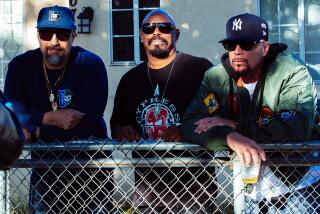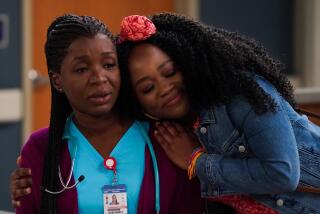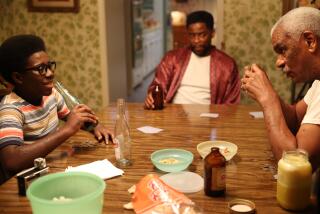That’s Not All, Folks--Cartoons Join Drug War : Children’s TV: On Saturday, networks will simulcast ‘Cartoon All-Stars to the Rescue,’ an animated feature on drug abuse.
- Share via
The next network simulcast isn’t going to be a presidential press conference or a space shot. It’s not going to bring news about an earthquake or coverage of an invasion. And it’s not going to be in prime time.
The next network simulcast is going to be a cartoon.
On Saturday at 9:30 a.m. (PDT), ABC, CBS, NBC and Fox will simultaneously air “Cartoon All-Stars to the Rescue,” an animated half-hour program about drug abuse. Cable networks and independent stations across the country--including the Disney Channel, USA Network, Black Entertainment Network, Nickelodeon and KCOP Channel 13 in Los Angeles--also will air it, although not all of them will do so at the same time.
Conceived by the Academy of Television Arts & Sciences and produced under the auspices of Walt Disney Co. vice chairman Roy Disney, the program uses characters from Bugs Bunny to Miss Piggy and the Smurfs in an attempt to teach youngsters about the dangers of using illegal drugs.
The story focuses on a 9-year-old girl named Corey, who learns that her 14-year-old brother is using drugs when he breaks into her piggy bank to steal money to buy marijuana. The cartoon characters, who come to life from among Corey’s books and stuffed toys, help her figure out what’s going on, and eventually persuade the older boy to stop using.
George C. Scott plays the voice of the cartoon’s villain, a fantasy character named Smoke, who is made from the smoke from a marijuana cigarette. And Academy Award-winning songwriters Howard Ashman and Alan Menken (“The Little Mermaid”) contributed a song that offers children more than a dozen ways to “say no to drugs.”
The program has benefitted from a multimillion dollar promotional campaign that started with a carefully timed endorsement from President Bush during a speech to the television academy in March. The McDonalds Corp. and its Ronald McDonald Childrens Charities provided $2 million for the production and a related anti-substance abuse campaign that will involve passing out 250 million pamphlets about the program at McDonalds restaurants and distributing tapes to video stores and schools.
Although it has not yet been seen by reviewers--the final version was still being edited Thursday--the program has been heralded for bringing about unusual cooperation among rival cartoon studios and networks. Bush has said that he wants every child in America to watch it. He and his wife, Barbara, taped several endorsement spots to promote the program on network television.
Some observers, however, have raised questions about the effectiveness of “Cartoon All-Stars to the Rescue,” which does not address problems such as alcohol abuse, and which focuses on a white, middle-class family with no obvious dysfunction. There are children of color in the program, but they are among the street-tough adolescents with whom Michael, the older brother, shares drugs.
“So much of drug education hits those who need it least,” said Dr. Daniel X. Freedman, a professor of psychiatry and pharmacology at UCLA and acting head of the UCLA medical school’s psychiatry department. “Then you hope that they set such a style that the rest will say, ‘I want to be like them.’ ”
Robert Coombs, professor of biological behavioral sciences at the UCLA School of Medicine, said that the program might be more effective if it dealt as extensively with alcohol as it does with other drugs.
“For adolescents, alcohol is the main drug,” Coombs said. “Most kids, when they go to parties, (find that) alcohol is the most immediate drug. Marijuana is second and cocaine third. So to ignore the main drug and talk only about the drugs (that) the inner-city kids use, it’s ineffective. If we were really interested in these kids’ health, we would start off with the main drugs.”
Disney, who served as executive producer of the program, said that the focus was deliberately limited. Otherwise, he said, it would be too complicated for the 5- to 10-year-old age group at which it is aimed.
“We are not all things to all people, and we are not going to solve the drug problem with a 30-minute TV show,” Disney said. “And we’ve got to be very, very careful in thinking about it. You’ve just got to think, ‘Maybe I’ll make a dent.’ ”
Producer Buzz Potamkin said that alcohol was left out because it was too complicated to explain to children that it was OK to drink a liquid such as orange juice, but not one such as beer.
“If you use drugs, it is completely different from the normal action pattern for children,” Potamkin said. “They don’t normally smoke, they don’t normally snort things. On the other hand, they drink every day of their lives. They drink orange juice, they drink water, they drink milk.”
But regardless of whether the program actually serves to turn youngsters away from drugs, at least it might start a dialogue about substance abuse among parents and children, argued Ken Barun, director of Ronald McDonald Children’s Charities and the former coordinator of Nancy Reagan’s “Just Say No” campaign.
“Parents are scared to talk to their kids about drugs, like they’re scared to talk to them about sex,” Barun said. “First of all, they don’t feel they know enough about it to speak in an informed manner. Secondly, they don’t really understand it themselves.”
More to Read
The complete guide to home viewing
Get Screen Gab for everything about the TV shows and streaming movies everyone’s talking about.
You may occasionally receive promotional content from the Los Angeles Times.






